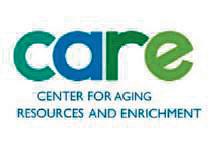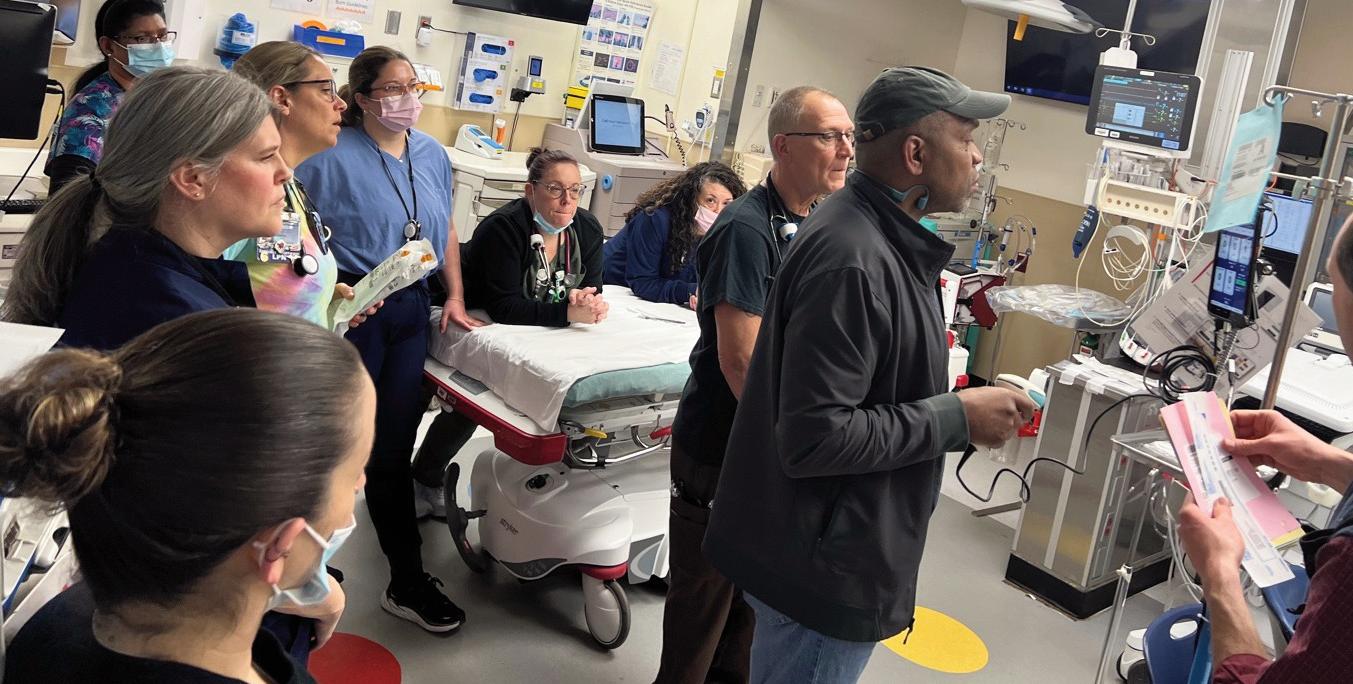YE A R IN REVIEW
AN OVERVIEW OF UPSTATE’S ADULT TRAUMA CENTER PROGRAM



The Region’s Only Level-One Trauma Center






The Region’s Only Level-One Trauma Center



In this report, the Trauma Program leadership team at Upstate University Hospital reflects on a year defined by unparalleled teamwork, remarkable achievements and an unwavering commitment to serving our region's most traumatically injured and vulnerable patients. Here, we share triumphs and lessons learned, and express our deepest gratitude for the collaborative spirit that fuels our success.
2023 brought forth an exceptional validation of our dedication to excellence. Achieving re-verification as a Level 1 Trauma Center by the American College of Surgeons (ACS) was a testament to the tireless efforts of our entire team –physicians, nurses, therapists, technicians, social workers, administrative staff, and countless others. It marked a moment of immense pride, not just for our

hospital, but for the broader network of healthcare providers who contribute to a seamless trauma care system across our CNY region.
However, accolades are truly meaningful only when measured against the impact we have on the lives entrusted to our care. It is with immense satisfaction that we report exceptional patient outcomes— exceeding national benchmarks in key areas like elderly survival rates and low surgical complication rates. These triumphs are the heart of our mission, and they speak volumes about the expertise, compassion and unwavering dedication of everyone who touches the lives of our patients.
Beyond the walls of our trauma center, 2023 saw our commitment to outreach, education, and injury
prevention blossom. Our injury prevention efforts reached hundreds of community members, empowering individuals to make informed choices that can avert tragedy. We fostered deeper collaboration with EMS agencies, optimizing pre-hospital care and streamlining patient transitions. Our commitment to research supports the development of best practices in trauma care. With our long list of trauma educational programs, we shared those best practices with the medical community we serve. Internally, our robust performance improvement initiatives yielded real-world results, ensuring continuous quality enhancement and a relentless pursuit of the best possible outcomes.
Throughout this journey, we have been profoundly humbled by the
Roseanna Guzman-Curtis, MD, MPH, FACS
Trauma Medical DirectorMelaina King, BSN, RN, CCRN, TCRN
Trauma Program Managerincredible partnership we enjoy with each and every one of you. This includes prehospital providers, referring hospital providers, Upstate leadership and specialists, and anyone who provides direct or indirect patient care – it truly takes a village to nurture a Level 1 Trauma Center. We extend our heartfelt gratitude for your unwavering support, shared expertise, and commitment to a common goal: providing the highest quality of care to those who need it most.
For 2024, the unyielding pursuit of excellence remains our compass. We are driven by the belief that every life lost to trauma is one too many, and we will continue to push the boundaries of innovation and collaboration to make our system even stronger and more impactful. We look forward to facing the

challenges ahead, hand-in-hand with our valued partners, knowing that together, we can continue to build a system that provides exceptional care to our region for generations to come.
With sincere appreciation, Roseanna Guzman-Curtis, MD, MPH, FACS
Melaina King, BSN, RN, CCRN, TCRN
Upstate Trauma Partners with NYS DOH and EMS
EMS provides a critical role in the care of trauma patients. EMS agencies can better evaluate the care they provide when they have the information concerning the assessment, diagnosis and treatment of the patient in the hospital.
Upstate Trauma Center and the New York State Department of Health (DOH) partnered to automate the required sharing of this key

information with EMS agencies. In the past, this information was manually transmitted to the EMS agency that cared for the patient. The new method permits EMS agencies to obtain this information more quickly.
Trauma Centers maintain a comprehensive registry of all trauma patients treated at their facilities. Upstate and the DOH worked
14 counties in the central New York Trauma service area
Broome Cayuga Chenango Cortland Herkimer Jefferson Lewis Madison Oneida Onondaga
Oswego St. Lawrence Tioga Tompkins
Central New York Trauma Centers
Upstate Medical University
Level 1 - Adult and Pediatric
UHS Wilson Medical Center
Level 2 - Adult
together, along with our registry vendor ImageTrend, to facilitate the automatic release of this information to the EMS agency that cared for the patient. With this information, EMS agencies are better able to evaluate the care they provide and seek additional education, with the goal of improving care of trauma patients.

Canton-Potsdam Hospital
Level 3 - Adult
Wynn Hospital - Provisional Level 3 - Adult


Three online trauma courses have been added to Upstate’s online learning program, Brightspace, which provides trauma education geared towards new nurses all the way to experienced trauma nurses.
All new nurses are assigned the new nurse orientation module, Trauma System Overview, which provides information about the Upstate Trauma Center and its role in the trauma system. It also serves to introduce the trauma program staff.
The Basic Trauma Education Course covers the following topics:
• Kinematics
• Thoracic Trauma
• Genitourinary Trauma
• Neurological Trauma
• Trauma and Pregnancy
• Shock
• Abdominal Trauma
• Orthopedic Trauma
• Maxillo-Facial Trauma
The Advanced Trauma Education Course focuses on the same topics as the basic course with the addition of critical care considerations.
Rural Trauma Team Development Course
– Don't Let the Name Fool You
Think of this course as trauma team development for the non-trauma center. It is a way for non-trauma centers to be
introduced to the key components of a trauma team and how they can develop these teams in their facilities. Upstate encourages hospitals in the Central New York Trauma Region to schedule this full-day course at their facility.


The was developed by the American College of Surgeons and has the following objectives:
• Organize a rural trauma team with defined roles and responsibilities for the members
• Prepare a rural facility for the appropriate care of the injured patient Identify local resources and limitations
• Assess and resuscitate a trauma patient Initiate the transfer process early
• Establish a performance improvement process
• Encourage effective communication
• Define the relationship between the rural trauma facility and the regional trauma system
Contact us to find out more about this class.




Injuries are the leading cause of death and disability in the U.S. for individuals age 1 to 44 (CDC WISQARS, 2023). Upstate’s Level 1 Trauma Center is committed to the total care of our community, from prevention through recovery. Upstate is the second-busiest trauma center in New York state with an average of 3,500 trauma registry entries annually.
Upstate injury prevention efforts reach our communities through social media, in-person programming, webinars, lectures and, most importantly, our local partners. Our top mechanisms of injury include falls, motor vehicle crashes and violence.
Falls are the leading cause for traumatic injury, and accounted for 45% of our total injuries in 2023. A collaborative partnership with the
Onondaga County Office for Aging has allowed us to effectively distribute 600 fall prevention placemats and nightlights (‘Plug-in before you fall’) in 2023 to seniors who also participate in the Onondaga County Public Meal Assistance program.

Tai Chi for fall prevention is provided to local community members with the collaboration of our partners at Upstate Oasis via online classes. Over the past four years, including 2023, 835 participants have completed this program.
Motor vehicle crashes are the second leading cause of injury treated at Upstate, making up 13% of all Upstate trauma admissions in 2023.
Of that number, approximately 33% of these crashes are drivers between the ages of 14 and 29. ‘Let’s Not Meet by Accident’ has been a part of the trauma center’s injury prevention education for more than 20 years. The program is designed to highlight how individual choices in a vehicle have consequences. Students identify driving distractors, then conduct a simulated crash scenario of a mass casualty incident with the assistance of local fire departments, air medical agencies, ambulance agencies and police agencies. In the last two years, 848 students have participated in this program. One student reported, “It was very eye-opening and cool to see. I have already been telling my brother and sister about how important it is to wear your seat belt and to not be on your phone when you drive.”
Violence related injuries are the third leading cause of injury seen at Upstate, making up 15% of Upstate Trauma’s annual admissions in 2023. Upstate’s Violence Education Prevention Outreach Program (VEPOP) is our hospital-based violence intervention program. The Upstate trauma center has a dedicated social worker, Renee Gregg, who meets with patients who have been affected by violence to learn more about their needs and how violence has impacted them. Together, along with many other partners in our community she works tirelessly to link patients affected by violence with intensive case management services and various programs such as career assistance, school programs, housing programs, addiction help, etc. to find alternatives to violent lifestyles.

Stop the Bleed is an international program that teaches life-saving techniques for controlling bleeding. We provide regular Stop the Bleed education to members of our community, teaching them how to effectively use direct pressure, wound packing, and tourniquet application. Proper bleeding control techniques have been proven to save lives. Since its implementation Upstate Trauma has trained more than 3,000 people in Stop the Bleed across our 14-county region.


During Barry Park Community Day, VEPOP participants wore ‘Orange against violence’ shirts to raise awareness VEPOP teamed up with community partners including AMR, the Syracuse Fire Department, and ‘Let Me Be Great’, an organization formed after 21-year-old Rasheed Baker was shot in front of his home in Syracuse. It was founded in 2017 by Rasheed’s mother, Rasheada Caldwell, and promotes safe practices and community involvement to prevent such violence.

On November 18, 2023, Upstate Trauma and Upstate Safe Kids teamed up to recognize National Injury Prevention Day by calling on local landmarks to Go Green! Upstate Trauma received a proclamation from the County of Onondaga and City of Syracuse. The trauma center proudly recognized all Upstate buildings, the JMA Dome at Syracuse University, St. Joseph’s Health and Syracuse City Hall who chose to display green lights for National Injury Prevention Day.

Upstate team brought attention to National Stop the Bleed Day in May 2023, while instructing a group of incoming medical students at Upstate’s Norton College of Medicine.



Our three adult trauma PI Coordinators: Shelby Brabant, MSN, RN; Allison Rondenelli, MSN, RN; and Emily Ducey, BSN, CCRN, RN
Adding Emily Ducey and Allison Rondenelli to our Performance Improvement (PI) team was welcomed by our entire trauma program, but especially by Shelby Brabant, who was our program’s only PI coordinator before their arrival. Together, these three leaders have combined their unique talents and experiences to increase the caliber of our PI program through their attention to detail, data analysis and excellent recordkeeping. Their knowledge and diligence during the verification was invaluable to our reverification efforts.
The addition of new PI personnel allowed for more balanced workflows and provided the PI team with more opportunities to communicate and integrate with bedside staff to ensure awareness of real-time events and concerns. The PI program created a unique rounding tool which highlights potential areas for improvement by concurrently identifying patients who may need review and a closer analysis of their care.


The PI plan contains templates used by PI Coordinators to evaluate the care provided and to conduct reviews uniformly
Upstate’s three PI Coordinators attended their first TraumaCon in Denver, CO, and learned better ways to streamline the process of measuring compliance with Clinical Practice Guidelines, a new standard set forth by the ACS in 2022, which Upstate Trauma has now implemented.

The PI program's goal is to deliver optimal care to all traumatically injured patients through chart reviews, monitoring, and establishing processes to improve direct and indirect patient care. At the heart of the PI program is the PI plan, an all-encompassing internal document that thoroughly explains each component of the PI program, including the mission and goals, identifying key stakeholders, and levels and type of chart review. The trauma program has a formal and validated performance improvement process that allows for clear problem identification
and thorough review of available data. The review process serves as the foundation for improving trauma performance and allows for clinical analysis of cases, supports a multidisciplinary approach to rapid event resolution through the identification of action items, and ultimately achieves loop closure to ensure that future, similar trauma patients will experience improved outcomes.
In today’s healthcare arena, change is constant and quality is a critical priority. As a result, the trauma PI Coordinators and Trauma Program Manager were
proactive in modifying the PI plan in preparation for Upstate Trauma’s reverification in December of 2023. This ensured that the PI plan was concurrent with the updated standards set forth by the American College of Surgeons (ACS). Within these new standards, the PI team was responsible for ensuring that over 20 Performance Improvement Patient Safety Core Measures were adhered to, including the review of all non-surgical admissions, compliance with trauma team activation criteria and clinician response times to our most critically injured patients, and more.


Upstate was in the top 10 % in the nation for:
Lowest risk-adjusted mortality for Elderly Blunt Multisystem Trauma Patients.
Lowest Surgical Site Infection for all patients.
Lowest acute kidney injury (AKI) for all patients.
The Trauma Quality Improvement Program (TQIP) is considered a quality improvement tool which evaluates trauma center performance based on defined cohorts and outcomes. It is a biannual report comparing Upstate’s trauma center performance to other participating trauma centers. Nationwide, over 900 trauma centers participate in TQIP, and the ACS now requires trauma centers to submit their data to a benchmarking platform.
TQIP collects data from the trauma center and then provides feedback about the center’s performance and identifies characteristics that the trauma center can implement to improve patient outcomes. The TQIP program uses risk-adjusted benchmarking to provide Upstate’s Trauma Program with accurate national comparisons and specifies cohorts that may be under or overperforming.
The TQIP report not only gives Upstate’s Trauma Center key areas for detailed analysis and review but works to elevate the quality of care for trauma patients.
Our trauma surgeons sporting Dr. Marx-themed surgical caps while standing in front a plaque that hangs in the Surgical Intensive Care Unit to honor Dr. Marx's contributions to Upstate Trauma spanning 30 years.




Upstate Trauma Services is proud to promote collaboration within various Upstate departments to provide exceptional trauma care. The Upstate Department of Emergency Management in conjunction with the Central New York Hospital Training Center (CNYHTC) provides a valuable partnership that promotes disaster management awareness, training and education to members of the Central NY community. In 2023, the following enhancements were reported:
• Upstate University Hospital’s Adult Emergency Department Canopy Project was completed. In addition to protecting our patients and ambulance providers from the elements, decontamination capabilities were overhauled and augmented. The addition of a threelane multifunctional decontamination system provides rapid response for the Emergency Department and increases the number per hour SUNY Upstate can decontaminate by a factor of four.
• Trauma Services increased our partnership with the CNYHTC to provide training across the region. Health Emergency Preparedness Training Centers (HTCs) are grantfunded entities tasked with identification, coordination, development, delivery, and/or evaluation of emergency preparedness training for members of the Healthcare Emergency Preparedness Coalitions. HTCs are funded by the New York State Department of Health (DOH) through the national Hospital Preparedness Program (HPP) grant. Trauma Services completed a Stop the Bleed instructor-based training for members of the CNYHEPC.
• Upstate specific Trauma Response Training was conducted for administrators on-call with the inclusion of the Adult and Pediatric Trauma services, as well as the Clark Burn Center. The AOC serves as the primary Incident Commander during emergencies that impact the organization's normal operations, for both clinical and non-clinical


leadership personnel. These three separate training sessions focused on trauma specific resource needs and communication pathways to ensure SUNY Upstate was able to respond efficiently. In addition, these discussion-based trainings often identify opportunities for improvement that the organization can fix prior to any real event.
• Upstate Trauma Services participated in local and state Emergency Preparedness Drills to evaluate and recommend appropriate care for trauma patients and maximize surgical surge capacity. An appendix was added to Upstate’s all-encompassing disaster plan to detail processes to be enacted in the event of a surgical surge/disaster.
• The CNYHTC provided grant funding to support formal trauma education including ATLS (Advanced Trauma Life Support) ATCN (Advanced Trauma Care for Nurses) and RTTDC (Rural Trauma Team Development Course).




5A is a 25-bed medical-surgical unit at Upstate University Hospital that manages trauma patients who no longer need ICU or Stepdown level of care. Trauma patients at this level still require great care, and the skilled multidisciplinary team on 5A provides that readily. This unit's staff specialize in the care of trauma patients and other patients that have undergone surgery. Working on a Trauma/Med-Surg floor is demanding, and no two days are the same. The dedicated nursing team consists of staff nurses, clinical leaders, a clinical nurse specialist, and nursing assistants that work together and collaborate with physicians and interdisciplinary teams to coordinate care delivery and ensure safe, effective, high-quality patient care.
“Working on 5A has been a great experience! Not only have I been able to learn new things every day, but I have been able to help patients heal. To be able to watch someone go from bedridden to walking, even if it’s only a few steps, is very satisfying. Many patients stick with us even after they are discharged, knowing that we as a unit helped get them to the point they can join their families again feels amazing and adds to the reason I chose this career!” -
CharlyneBurlingame RN, 5A Clinical Leader


Trauma
Patient Age
Distribution
Percentages
(There are over 50 Trauma centers in New York)

Challenge Coin:





In 2022, Upstate Trauma introduced its first ever Challenge Coin created in memory of Dr. William Marx, DO our former Trauma Medical Director. The coin was widely distributed and became popular as a token of appreciation and support to the trauma center’s vision.
In 2023, Trauma Services decided to highlight the Trauma Survivors Network (TSN) here at Upstate University Hospital. TSN is a world-wide community of patients who are looking to connect with one another and rebuild their lives after serious injury. Becoming a member is free of charge and is very simple. Patients or caregivers can enroll online by scanning the QR code on the back of the coin. Joining provides patients and their families with access to support groups, forums, survivor and family stories, recovery assessments, classes and much more.





Upstate Trauma Center is thrilled to announce a groundbreaking new program for 2024, prioritizing the complete recovery of our patients – mind, body, and soul. Recognizing the profound impact of trauma on mental health, we've welcomed a dedicated Trauma Nurse Navigator (TNN) and a Trauma and Burn Psychologist to our team. The TNN acts as a compassionate guide, screening patients for potential PTSD and depression, offering support, and seamlessly connecting them with the psychologist for specialized care. This ensures timely intervention, aimed at preventing debilitating mental health aftereffects. But our support extends beyond the hospital walls. We've actively built a robust Trauma Survivors Network (TSN) and curated diverse resources to empower patients transitioning back to their lives. Gone are the days where healing solely focused on physical mending. By addressing the oftenoverlooked emotional and mental toll of physical trauma, Upstate Trauma Center is setting a new standard of care. This holistic approach not only fosters better long-term outcomes for our patients but also reaffirms our commitment to their well-being every step of the way. Join us in celebrating this momentous step towards whole-person trauma care in 2024!
A new collaboration has been established between Upstate Trauma and the LeMoyne Center for Aging Resources and Enrichment (CARE). CARE offers a 7-week fall prevention program in Onondaga County where Occupational Therapists will teach individuals about changes to make in the home, community, and exercises to prevent falls and how to recover from a fall.




During the adult trauma program’s 2021 reverification focused visit, the ACS recommended a more organized and thorough process for collecting and reviewing Massive Transfusion (MTP) cases. As a result, the trauma department sought out an improved technique for tracking MTP cases via the Arcos Blood Navigator ®. It rapidly tracks blood product transfusions throughout the hospital, including between different environments such as the Emergency Department and Operating Room. Through barcode scanning, the Arcos Blood Navigator avoids using paper blood tags to track quantities, volumes, and timing. It also provides a chronological record of MTP events, including timing and quantities of products given, in hopes of ensuring balanced transfusions and improving the PI review process. Overall, the Arcos Blood Navigator allows for a more streamlined and
organized collection process of massively transfused products, with the aim of improving outcomes.
The trauma program recognized that implementing such a product required substantial effort from multidisciplinary stakeholders such as clinical staff, Information Management & Technology (IMT), administration, and education personnel. Multidisciplinary collaboration and communication were paramount to the planning and implementation of the Arcos Blood Navigator. The trauma program extends gracious appreciation to all those involved in this critical improvement in trauma care and looks forward to the outcome of this pilot project which rolled out in February 2024.

Syracuse, NY 13210




